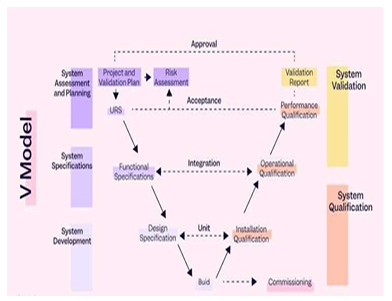Computer System Validation of UV Spectroscopy Instrument Software (CARRY UV) using V Model
DOI:
https://doi.org/10.5530/ctbp.2024.3s.23Keywords:
Installation Qualification, Operational Qualification, Performance Qualification, quality, safety, identity, efficacyAbstract
Computer System Validation (CSV) is a critical aspect of ensuring that any software or system used in regulated environments, such as pharmaceuticals, healthcare, and biotechnology, meets its intended purpose and operates consistently within specified parameters. The UV spectroscopy instrument, specifically the CARRY UV software, is a pivotal tool in analytical laboratories for measuring the absorbance and transmission of ultraviolet and visible light by a sample. Validating this software using the V-Model ensures its reliability, accuracy, and compliance with regulatory standards. The VModel, or Validation Model, is a systematic approach widely used in software development and validation. It emphasizes verification and validation activities corresponding to each stage of the software development lifecycle. Key aspects include accuracy in measurement, data integrity, user access controls, and audit trails. This stage involves outlining the software's capabilities, such as wavelength range, data processing algorithms, user interface design, and integration with laboratory information management systems (LIMS). The design specifications phase involves creating a blueprint for the software's architecture. This includes the design of databases, software modules, and user interfaces. For CARRY UV software, it is crucial to ensure that the design supports robust data handling, secure user access, and accurate data processing. For the CARRY UV software, developers must focus on implementing algorithms for accurate spectral data analysis and ensuring the software's compatibility with various hardware configurations. Integration testing involves combining individual modules and testing them as a group. System testing validates the complete and integrated software to ensure it meets the specified requirements. For the CARRY UV software, this involves testing the entire workflow from sample measurement to data analysis and reporting. It ensures the software performs reliably under different conditions and usage scenarios Users test the CARRY UV software in a real-world environment to ensure it performs as expected. This phase includes installation qualification (IQ), operational qualification (OQ), and performance qualification (PQ) to ensure the CARRY UV software is installed correctly, operates according to specifications, and performs consistently in the production environment. Throughout the validation process, meticulous documentation is maintained. This includes validation plans, test scripts, test results, and validation reports. Documentation is essential for demonstrating compliance with regulatory requirements, such as those set by the FDA, EMA, or other relevant authorities. Validating the CARRY UV software using the V Model ensures a structured and thorough approach to verifying and validating the software's functionality, performance, and compliance. This methodical process helps identify and mitigate risks early, ensuring the software's reliability and integrity in critical analytical applications. Through rigorous testing and documentation, the V Model supports the delivery of a robust and compliant UV spectroscopy instrument software, ultimately enhancing laboratory efficiency and accuracy.



